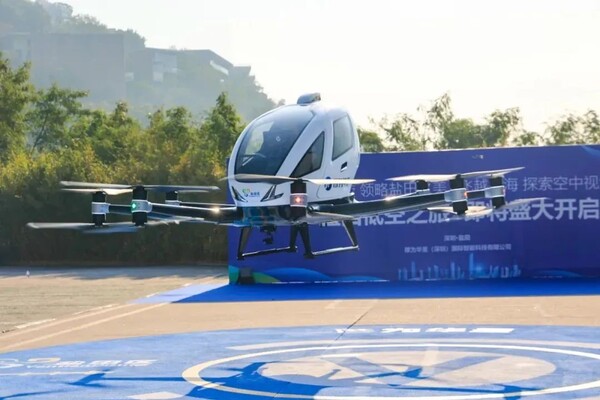By Cheng Yuanzhou, People's Daily
After meals were packed, weighed, and mounted to drones, these unmanned aerial vehicles (UAVs) took off under unified control, and arrived at office buildings across an overpass in just two minutes. They autonomously delivered the meals and returned.
The delivery drone fleet has become a spectacle in a commercial area in Longgang district, Shenzhen, south China's Guangdong province.
"In this commercial area, the drones deliver over 300 orders every day. During the lunchtime, they take off and land almost every minute," said Yan Yan, head of public affairs for drone operations at Meituan, a Chinese shopping platform for locally found consumer products and retail services.

According to Yan, Meituan has opened multiple drone routes in Shenzhen, delivering a total of over 200,000 orders to communities, office buildings, tourist attractions, hospitals, and universities. The platform has established a community drone delivery model that is able to delivery orders to destinations within 3 kilometers in 15 minutes.
In fact, food delivery by drones is no longer a novelty in Shenzhen. From sightseeing to urban security, from medical assistance to emergency rescue, and from agricultural and forestry protection to power line inspections, the low-altitude economy is finding more and more application scenarios in Shenzhen.
For instance, taking a helicopter ride operated by Heli-Eastern has become a convenient transportation option for citizens going from Shenzhen Bao'an International Airport to areas like Guangming and Pingshan districts of Shenzhen; a "lifeline" for transporting blood products via drones from the Shenzhen Blood Center to hospitals in Nanshan and Bao'an districts has been established; at the power transmission management office of Shenzhen Power Supply Bureau Co., Ltd., 5G-enabled drones have been employed regularly in high-voltage cable terminal inspection on transmission towers.

"Shenzhen has listed the low-altitude economy as one of the 20 key strategic emerging sectors for development. The city aims to drive the development of this new sector with technological innovation and by creating more application scenarios," said Zhao Ke, an official of the Shenzhen Municipal Bureau of Transport.
According to Zhao, Shenzhen has opened 126 low-altitude air routes and established 89 unmanned aerial vehicle takeoff and landing points. Last year, the city saw 600,000 flights of cargo drones and 20,000 flights of helicopters, Zhao said.
Yang Jincai, chairman of the Shenzhen UAV Industry Association, revealed that by 2023, Shenzhen reported low-altitude economy output of 96 billion yuan ($13.35 billion), and was home to over 1,700 companies engaged in the industry. The city has developed a complete industrial chain covering drone R&D, design, manufacturing, operation and support.
Currently, Shenzhen holds a market share of over 70 percent in the consumer drone sector globally, and 50 percent in the industrial drone sector.

The rapid development of the low-altitude economy in Shenzhen is attributed to the city's strategic efforts to seize development opportunities and continuously improve relevant policy systems.
In 2017, Shenzhen became a comprehensive demonstration zone for the general aviation industry. In 2019, measures were introduced to designate airspace for micro and light UAVs. On Feb. 1 of this year, regulations on the promotion of the low-altitude economy in the Shenzhen Special Economic Zone officially came into effect, normalizing the development of the low-altitude economy in terms of infrastructure, flight services, industrial applications, technological innovation, and safety management.
Zhao said that the first phase of a project on promoting infrastructure for intelligent low-altitude integration in Shenzhen is currently accelerating its pace. The project aims to preliminarily establish an infrastructure network, air connectivity network, flight route network, and service network to support the low-altitude economy.
Besides, innovative platforms such as a smart air traffic operation laboratory are also being constructed. In the future, Shenzhen will gradually carry out UAV operations and integrated flight verification, as well as develop regulations, standards, and norms for low-altitude flights.


